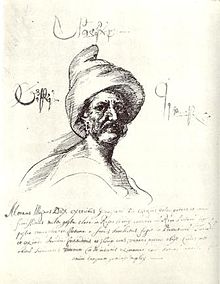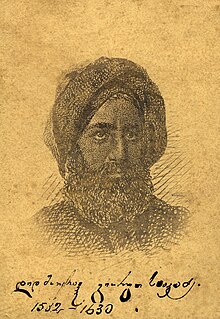Giorgi Saakadze

Giorgi Saakadze (* around 1570, Peli, Kingdom of Kartlien , † October 3, 1629 in Aleppo ) was a Georgian general and politician. He was governor (Mouravi) in Tbilisi and is known in Georgian history as Grand Mouravi (Didi Mouravi). He is one of the most popular and controversial figures in Georgian history.
Also Mourav Beg, Maghraw, Meurab, Mehrou.
Beginnings and struggle under Luarsab II against the Turks
Saakadze came from the lower nobility (called Aznauri in Georgia). His father Siaush served the king of Kartlien Simon I (1537-1611) and was rewarded with goods in Kartlien. Back then, Turks and Persians were fighting for influence in Georgia and the respective rulers were mostly vassals of one of the two powers. Simon I was a vassal of the Persians and fought first against the Persians and then against the Turks, was captured in 1599 and died in captivity in Constantinople. His successor was a son of Simon I, Giorgi X. (around 1561-1606), who was a Persian vassal, and after his death his son Luarsab II (1582-1622). Saakadze was appointed governor of Tbilisi, Tskhinvali and Dwaleti in 1608. Saakadze had married into the influential Georgian family of the high nobleman Zurab Eristavi (around 1591-1629). The Ottomans sent a large army to Georgia in the summer of 1609 to remove Luarsab II from the throne, but were initially defeated by the Georgians under their general Saakadze in the battle of Tashishkari on June 16, 1609. With that he saved Luarsab II's throne and became the most powerful man at court, which aroused resentment among the high nobles. In 1611 the king married Saakadze's sister, Makrine, but in 1612 Saakadze was overthrown by a noble conspiracy led by Shadiman Baratashvili (who previously reigned Luarsab II during the minority period) and had to flee to Persia. The king divorced Makrine.
Fight on the side of the Persians and against them
Saakadze won the trust of Shah Abbas I and served in his army. In 1614 he led a Persian army to Kartlien and overthrew King Luarsab II (who was strangled in a Persian dungeon in 1622 after he refused to convert to Islam, which is why he is considered a martyr in Georgia). There were many victims among the population and extensive displacement. The Shah installed a new regent, Bagrat VII., In Kartlien (a relative of Luarsab, but who was Muslim) and Saakadze became his minister in 1619 and in fact the actual ruler of the country. He also served in leading positions in the Persian army. When he was in Georgia in 1625 to suppress a revolt with the Persian army, he learned that they were planning a massacre of all armed cartoons (and that he himself was to be murdered) and allied himself with the Georgian insurgents, including King Teimuraz I (1589 –1661) from Kakheti . As an advisor to the Persian commander, he initially ensured that the troops (around 60,000 strong) were distributed. On March 25, 1625, the Georgians (from Kartli and Kakheti) under Zurab Eristavi attacked the Persian camp near Martquopi . Saakadze and his son Avtandil and some Georgian followers killed the surprised Persian leaders (where he himself killed Quarchegai Khan) in the command tent, and the Georgians were able to conquer the camp in the confusion and caused a massacre of the majority of the 30,000 men in the camp strong Persian army fell victim (only 3000 escaped). After the battle, Teimuraz, who had fled to Imereti, was made king of Kakheti and Kartlien with the support of Saakadze. Thereafter, Saakadze successfully continued the campaign against the Persians in Georgia and drove them from Tbilisi and other parts of the country. The Shah's governor in Kakheti was expelled and the Turkish nomadic peoples who settled the Persians after the Georgians were expelled from the country destroyed. The Shah then executed the youngest son Paata von Saakadze, who had remained hostage at the Persian court, and sent his head to the Georgians.
Battles of Marabda and Bazaleti and Turkish exile
The Shah now sent a large army of 60,000 men against the Georgians who were defeated in the costly Battle of Marabda on the Algeti River on July 1, 1625. The Persians were superior in both soldiers and firepower (artillery, muskets) (the Georgians had around 20,000 men) and Saakadze strongly advised against attacking first. Instead, he wanted to lure the Persians into the narrow Kodjori valley. But he was outvoted and instead of him King Teimuraz took command, who attacked in the plain near Marabda. The Persians were prepared for the attack and were entrenched in trenches that were defended by cannons and four rows of musket shooters. Still, the Georgians almost won. Their cavalry overran the center with artillery and musket shooters. Parts of the Georgian army were already celebrating the victory and looting the enemy field camp and its supplies (and Avtandil pursued the enemy with the cavalry, leaving the battlefield), but the Persians stood firm and received reinforcements, while the Georgians at the end of the one-day battle were exhausted. The Georgians lost the battle, but were still able to secure the retreat over the mountain passes. 14,000 Persians and 9,000 Georgians fell.
Saakadze organized a guerrilla war in the mountains, which caused heavy losses for the Persians. At the beginning of 1626 Saakadze succeeded in conquering important fortresses, but he also encountered resistance from local princes who feared his increasing power and allied themselves with the Persians. The Shah lost a total of 60,000 men (including 12,000 in a massacre in the Ksani Gorge) almost half of his entire army, but was able to recapture Tbilisi. Eventually the Shah was forced to recognize Teimuraz I as king. At the same time, there was a dispute among the Georgian leaders, as Saakadze did not believe that Teimuraz was able to unite all of Georgia. Another factor that played a role was that Teimuraz was jealous of Saakadze's reputation and that the Shah instigated the power struggle among the Georgians with intrigues. Saakadze was looking for allies against Teimuraz and found, among other things, the king Giorgi III. of Imereti (whose daughter married Saakadze Avtandil's son). In the battle of Bazaleti Saakadse was defeated in autumn 1626 by Teimuraz and had to go to Turkish exile, where he worked in the army of Sultan Ibrahim I. served. He converted again to Islam, was briefly governor of Vilayet Konya and then involved in the Turkish campaigns against Persia (in Erzurum in eastern Turkey 1627/28). Since the Grand Vizier of the Sultan Huzrev Pasha suspected him of making common cause with Georgian nobles and the Persians and feared his popularity, he was executed in Aleppo in 1629 with his son Avtandil and 40 Georgian followers.
His only surviving son Ioram rose to the high nobility in Georgia and founded the Tarchan-Mouravi family.
reception
Saakadze's subsequent reception was ambivalent. Important historians (such as Marie Felicité Brosset in the 19th century and Prince Vakhushti (1696–1757) von Kartlien in the 18th century) saw him in a negative light as an adventurer and ambitious warlord in the turbulent and checkered Georgian history of the 17th century.
Bishop Joseb of Tiflis (Bishop 1661 to 1686) saw him more positively with his poem Did-Mourawiani, which has a place in Georgian literature. Joseb himself was related to the family and wrote the poem shortly before he was murdered in 1688. It is based on an unsuccessful justification letter from Saakadze to Teimuraz (whom Saakadze suspected of wanting to murder him), and describes the life of Saakadze from 1609 (but saves the execution 1629 from). In the poem, Saakadze complains that he is seen as a traitor because his story was told by others.
In the 20th century he was seen as a forerunner of Georgian independence and as one of those who prevented the Islamization of the country (attempted establishment of Kizilbash khanates on Georgian territory by the Persians). In the 1940s, under Stalin, it served as a means of mobilizing Georgian nationalism during World War II. The film Giorgi Saakadze by Micheil Tschiaureli was made in 1942/43 . It was based on the six-volume novel The Great Mouravi by Anna Antonovskaya , which won the Stalin Prize in 1942. Saakadze was portrayed as the leader of Georgia, who rose from the small nobility, had to find his way through the power struggles and intrigues and betrayals of the nobility in connection with foreign rulers and fought for the unification of the country against foreign powers.
A battalion of Georgian Wehrmacht volunteers bore his name, Bataillon 797, which was stationed in France in 1943/44.
literature
- Donald Rayfield: Edge of Empires: A History of Georgia, Reaction Books, London 2012
- Alexander Mikaberidze: Historical Dictionary of Georgia, Rowman and Littlefield 2015
Web links
- Valeri Silogava, Khakha Shengelia, History of Georgia (web.archive)
Individual evidence
- ↑ In 1620 the Shah castrated his two sons, who were held hostage, one died in the process, the other went mad, and his Queen Ketevan was tortured to death in September 1624 because she did not want to convert to Islam, which would have been a propaganda success for the Shah. Teimuraz described her ordeal in a poem.
- ↑ Described in the story of Kartliens by the Turkish chronicler of the 17th century Mustafa Naima
- ^ Rayfield, Edge of Empires, p. 197
- ^ Pierer's Universal Lexicon, Georgian Literature , 1859
- ^ Donald Rayfield, The literature of Georgia, Routledge 1994, p. 109
- ↑ Thomas de Waal, The Caucasus, An Introduction, Oxford UP 2010, p. 86
| personal data | |
|---|---|
| SURNAME | Saakadze, Giorgi |
| ALTERNATIVE NAMES | Grand Mouravi; Saakadze, Giorgi |
| BRIEF DESCRIPTION | Georgian general and governor |
| DATE OF BIRTH | around 1570 |
| PLACE OF BIRTH | Peli |
| DATE OF DEATH | October 3, 1629 |
| Place of death | Aleppo |

